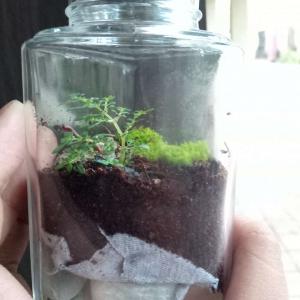文章
Dummer. ゛☀
2017年09月14日

Common in and around the home, ants range in size from about 1/32 to 3/4 inch long. They have three body parts (head, thorax and abdomen) and can be anywhere from a yellowish-red in color to black. Most ants are wingless, but winged forms exist during “swarming” or colony reproduction.
As a group, ants are important natural predators of many insect pests including flea and fly larvae, caterpillars and termites. However, there are times when it may be necessary to control ants especially when they enter our homes in search of food. Some ant species become problems in lawns and gardens when they build large unsightly mounds or protect aphids, mealybugs, scales and other insect pests from their natural enemies. Ants can also damage plants by tunneling around the roots causing them to dry out.
Tip: Look closely to determine if what you see is an ant or a termite. Ants have narrow waists and bent antennae. Termites have thick waists and straight antennae.
Life Cycle
All ants are social insects and live in colonies with three distinct types of adults called castes. Queens are larger than other ants and are responsible for egg laying. Some species have only one queen per colony whereas others have many. Males are responsible for mating with the queens; they do not participate in any other activities. Workers are sterile wingless females. They make up the bulk of the colony and are responsible for building and defending the nest, caring for the young and foraging for food.
New ant colonies are established by a single fertilized queen that lays hundreds of eggs. After about 30 days the eggs hatch into legless larvae that do not resemble adults. The queen cares for the “maggot-like” larvae until they pupate approximately 1-2 months later. Within three weeks the pupae transform into adult “worker” ants, which begin collecting food for themselves, the queen and for future generations of larvae. Eggs are laid continuously throughout the spring, summer and fall. Colonies overwinter in the soil, woody areas or in garden trash.
Note: Ants have pincer-like jaws and can bite although most do not. A few species are very aggressive and will inflict a painful sting. Here’s how to get rid of ants without harming your family, pets or the environment.
Control
Like all pests, ants require food and water to survive; by eliminating these basic necessities you can greatly reduce their numbers.
Store food and organic wastes in sealed containers, clean up all kitchen surfaces and empty trash daily.
Caulk cracks and crevices around foundations and apply Don’t Bug Me Spray to door and window jams to prevent entry from outside.
Where pipes and electrical wires enter the house spread Tanglefoot Pest Barrier to keep crawling pests outside.
Diatomaceous earth contains no toxic poisons and works quickly on contact. Dust lightly and evenly around areas where pest insects are found.
Apply Organic Insect Killer Granules around foundations, lawns and landscaped areas to eliminate or repel all kinds of crawling insects.
Dust Boric Acid lightly into cracks, crevices, wall voids and other insect hiding places. This fine powder clings to the legs, antennae and bodies of crawling insects and acts as a stomach poison when consumed during grooming.
Spray Orange Guard, made from citrus peel extract, to kill on contact. Approved for organic use, Orange Guard is a broad spectrum insect killer that’s safe to use indoors and out. Repeat applications may be necessary.
Safer Ant & Roach Killer is the first effective, truly organic aerosol that kills crawling insects in seconds. Best of all, it has a fresh citrus scent, so there is no chemical odor!
Tip: The best way to keep ants from coming indoors is to locate the mound and destroy the colony. While this is not always an easy task sometimes a chunk of jelly placed where ants are found will help. As the workers are attracted to the food source pay close attention as they carry it back to their nest. Set pre-filled outdoor bait stations where you find ant mounds or their trails. Botanical pesticides applied directly to the soil will also destroy existing mounds.
As a group, ants are important natural predators of many insect pests including flea and fly larvae, caterpillars and termites. However, there are times when it may be necessary to control ants especially when they enter our homes in search of food. Some ant species become problems in lawns and gardens when they build large unsightly mounds or protect aphids, mealybugs, scales and other insect pests from their natural enemies. Ants can also damage plants by tunneling around the roots causing them to dry out.

Tip: Look closely to determine if what you see is an ant or a termite. Ants have narrow waists and bent antennae. Termites have thick waists and straight antennae.
Life Cycle
All ants are social insects and live in colonies with three distinct types of adults called castes. Queens are larger than other ants and are responsible for egg laying. Some species have only one queen per colony whereas others have many. Males are responsible for mating with the queens; they do not participate in any other activities. Workers are sterile wingless females. They make up the bulk of the colony and are responsible for building and defending the nest, caring for the young and foraging for food.

New ant colonies are established by a single fertilized queen that lays hundreds of eggs. After about 30 days the eggs hatch into legless larvae that do not resemble adults. The queen cares for the “maggot-like” larvae until they pupate approximately 1-2 months later. Within three weeks the pupae transform into adult “worker” ants, which begin collecting food for themselves, the queen and for future generations of larvae. Eggs are laid continuously throughout the spring, summer and fall. Colonies overwinter in the soil, woody areas or in garden trash.
Note: Ants have pincer-like jaws and can bite although most do not. A few species are very aggressive and will inflict a painful sting. Here’s how to get rid of ants without harming your family, pets or the environment.

Control
Like all pests, ants require food and water to survive; by eliminating these basic necessities you can greatly reduce their numbers.
Store food and organic wastes in sealed containers, clean up all kitchen surfaces and empty trash daily.
Caulk cracks and crevices around foundations and apply Don’t Bug Me Spray to door and window jams to prevent entry from outside.
Where pipes and electrical wires enter the house spread Tanglefoot Pest Barrier to keep crawling pests outside.
Diatomaceous earth contains no toxic poisons and works quickly on contact. Dust lightly and evenly around areas where pest insects are found.
Apply Organic Insect Killer Granules around foundations, lawns and landscaped areas to eliminate or repel all kinds of crawling insects.
Dust Boric Acid lightly into cracks, crevices, wall voids and other insect hiding places. This fine powder clings to the legs, antennae and bodies of crawling insects and acts as a stomach poison when consumed during grooming.

Spray Orange Guard, made from citrus peel extract, to kill on contact. Approved for organic use, Orange Guard is a broad spectrum insect killer that’s safe to use indoors and out. Repeat applications may be necessary.
Safer Ant & Roach Killer is the first effective, truly organic aerosol that kills crawling insects in seconds. Best of all, it has a fresh citrus scent, so there is no chemical odor!

Tip: The best way to keep ants from coming indoors is to locate the mound and destroy the colony. While this is not always an easy task sometimes a chunk of jelly placed where ants are found will help. As the workers are attracted to the food source pay close attention as they carry it back to their nest. Set pre-filled outdoor bait stations where you find ant mounds or their trails. Botanical pesticides applied directly to the soil will also destroy existing mounds.
0
0
文章
权问薇
2017年09月13日

#杜鹃
1、选取半木质化的顶端枝条,剪下5~10厘米的长度,去掉枝条下面的叶子,只保留顶端的。
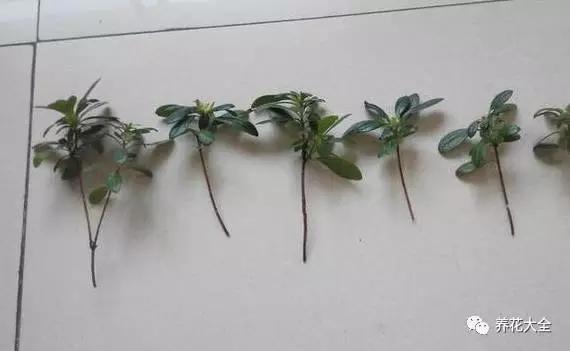
2、把处理好的杜鹃花枝条扦插到泡沫板中,枝条底部露出泡沫板三厘米左右。

3、把泡沫板放到一个大水缸中,先进行水培诱根。

4、等上半个月~1个月的时间,杜鹃就会长出根系,等根系长的健壮一些,差不多就可以进行上盆了。

5、上盆的时候,先把水培生根的杜鹃花捞出来,放在阴凉的地方晾个10分钟左右,再上盆,然后放到散射光处缓苗一段时间后再正常养护。

茶花
1、选择一年生的半木质化的枝条,用剪刀剪下10cm左右,顶端留3片叶子。

2、准备好干净的河沙,用河沙扦插生根会快。

3、把扦插用的枝条,伤口处放在多菌灵里泡一下,杀菌消毒,之后再在伤口上抹点儿生根粉,能够促进生根。

4、把枝条的1/3插进沙子中,浇透水,放在阴凉通风的地方,比如北阳台。

3、每天早晚用喷壶喷一次,一个月左右能够生根。如果空气湿度太低,可以套上个塑料袋哦~
但是塑料袋记得每天松开透透气。


月季
1.准备好刀片,剪刀,塑料瓶、透明胶带、蛭石。
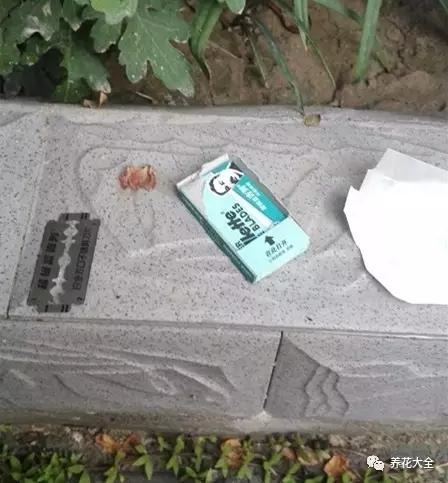
2、把塑料瓶瓶底剪掉,再竖着剪开。

3、选取生长健壮的月季枝条,在离地10到15厘米的距离上,用刀片环剥,环剥的长度大约1cm即可。就像是下图那样。

4.把剪好的塑料瓶瓶口朝下,掰开套在已经剥皮了的月季枝条上,然后用透明胶带把塑料瓶子粘好。

5.用蛭石把塑料瓶填满,浇透水。如果没有蛭石,也可以用珍珠岩之类的代替。
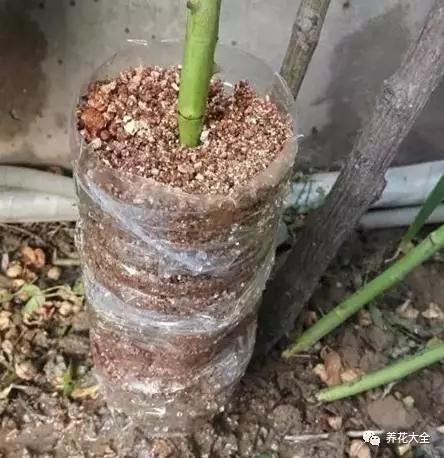
6.用塑料袋把封口封住,避免水分蒸发太快。

7.大约一个多月,就能长根,等根系长的健壮了一些,就可以去掉塑料瓶,然后移栽到新的花盆里了。在阴凉的地方缓根2~3天,就可以正常养护了。

茉莉
1、选择木质化的枝条,截取10cm。留顶端2片叶子,其余掐掉,以减少蒸发,就是留下的那两片叶子,也得剪掉一半。

2、将伤口处消毒之后,在生根粉溶液里面浸泡20分钟左右,阴干后插进细沙里。放在通风的墙角处,接受散射光即可。

3、每天喷洒水雾至少2次,保持湿度。大约1个月就能生根了。等根系长的健壮一些,再进行上盆即可。

栀子
1、截取2年生的枝条10cm。把下面的叶子摘掉,只留上面几片就行。

2、找个塑料瓶,倒上纯净水,把插条放进去。

3、瓶面覆盖保鲜膜,看见水没了就添点。当看见枝条表面长出白色的小凸起,就是快要长出根来了。出根后就能上盆了。

1、选取半木质化的顶端枝条,剪下5~10厘米的长度,去掉枝条下面的叶子,只保留顶端的。

2、把处理好的杜鹃花枝条扦插到泡沫板中,枝条底部露出泡沫板三厘米左右。

3、把泡沫板放到一个大水缸中,先进行水培诱根。

4、等上半个月~1个月的时间,杜鹃就会长出根系,等根系长的健壮一些,差不多就可以进行上盆了。

5、上盆的时候,先把水培生根的杜鹃花捞出来,放在阴凉的地方晾个10分钟左右,再上盆,然后放到散射光处缓苗一段时间后再正常养护。

茶花
1、选择一年生的半木质化的枝条,用剪刀剪下10cm左右,顶端留3片叶子。

2、准备好干净的河沙,用河沙扦插生根会快。

3、把扦插用的枝条,伤口处放在多菌灵里泡一下,杀菌消毒,之后再在伤口上抹点儿生根粉,能够促进生根。

4、把枝条的1/3插进沙子中,浇透水,放在阴凉通风的地方,比如北阳台。

3、每天早晚用喷壶喷一次,一个月左右能够生根。如果空气湿度太低,可以套上个塑料袋哦~
但是塑料袋记得每天松开透透气。


月季
1.准备好刀片,剪刀,塑料瓶、透明胶带、蛭石。

2、把塑料瓶瓶底剪掉,再竖着剪开。

3、选取生长健壮的月季枝条,在离地10到15厘米的距离上,用刀片环剥,环剥的长度大约1cm即可。就像是下图那样。

4.把剪好的塑料瓶瓶口朝下,掰开套在已经剥皮了的月季枝条上,然后用透明胶带把塑料瓶子粘好。

5.用蛭石把塑料瓶填满,浇透水。如果没有蛭石,也可以用珍珠岩之类的代替。

6.用塑料袋把封口封住,避免水分蒸发太快。

7.大约一个多月,就能长根,等根系长的健壮了一些,就可以去掉塑料瓶,然后移栽到新的花盆里了。在阴凉的地方缓根2~3天,就可以正常养护了。

茉莉
1、选择木质化的枝条,截取10cm。留顶端2片叶子,其余掐掉,以减少蒸发,就是留下的那两片叶子,也得剪掉一半。

2、将伤口处消毒之后,在生根粉溶液里面浸泡20分钟左右,阴干后插进细沙里。放在通风的墙角处,接受散射光即可。

3、每天喷洒水雾至少2次,保持湿度。大约1个月就能生根了。等根系长的健壮一些,再进行上盆即可。

栀子
1、截取2年生的枝条10cm。把下面的叶子摘掉,只留上面几片就行。

2、找个塑料瓶,倒上纯净水,把插条放进去。

3、瓶面覆盖保鲜膜,看见水没了就添点。当看见枝条表面长出白色的小凸起,就是快要长出根来了。出根后就能上盆了。

1
1
文章
Dummer. ゛☀
2017年09月13日

There is hardly a gardener out there who hasn’t encountered a Japanese beetle. The adult Japanese beetle is a shiny, metallic green with copper-brown wing covers and it’s about 3/8 of an inch in length. However, not all metallic green or copper beetles are Japanese Beetles. To make sure you're dealing with Japanese beetles check their undersides for five small, white tufts under the wing covers and an additional tuft at the end of the abdomen.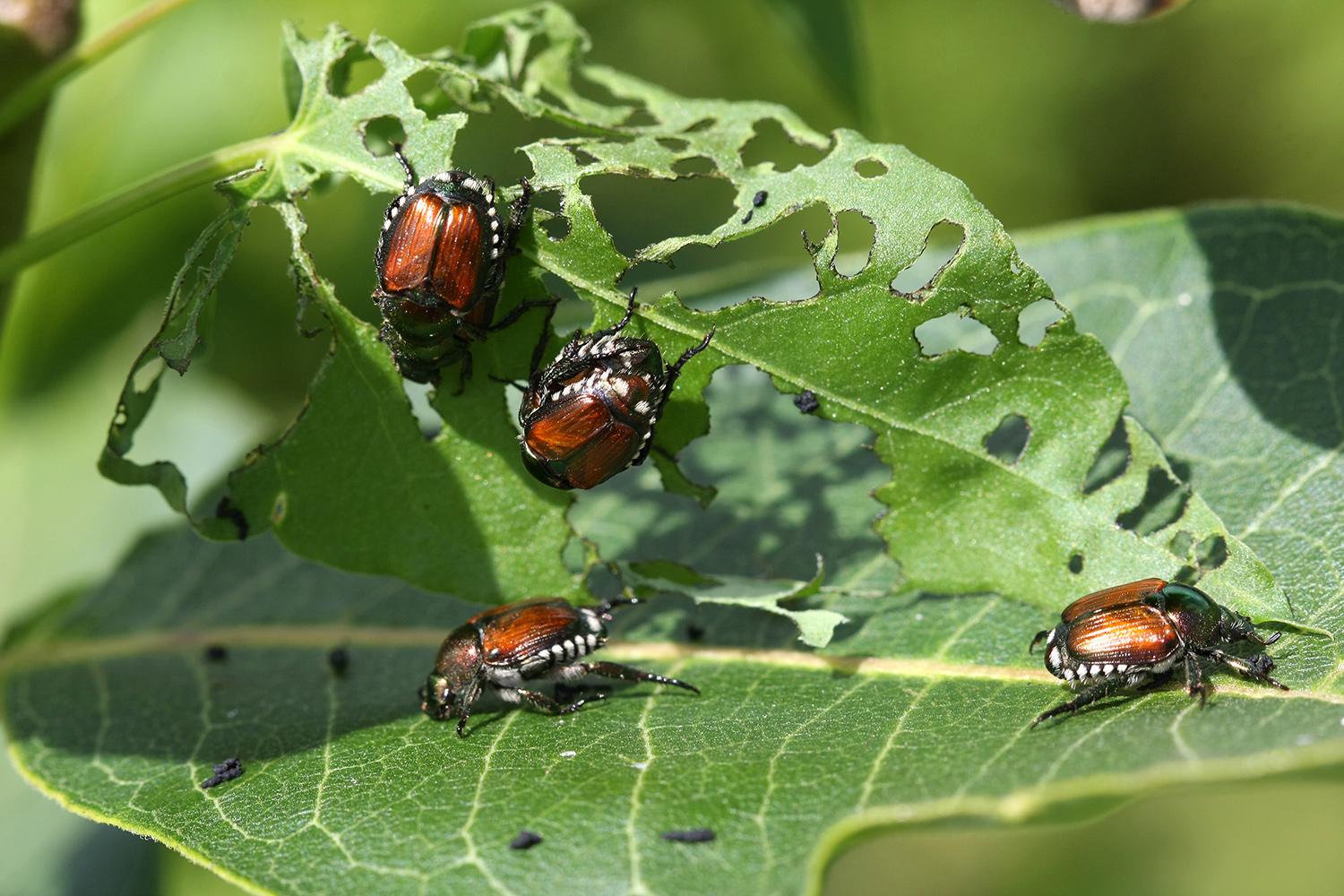
An individual Japanese beetle doesn’t do that much damage while feeding on a plant, but they tend to congregate in large numbers and can easily defoliate shrubs and trees. These bugs are hard to get rid of, but there are steps you can take to control them. Keep in mind that the adult Japanese beetles are only around for a little over a month, so don’t automatically reach for harsh chemicals unless they become a serious problem.
Stages of Development
Beetles typically go through 4 stages of development. It’s important to know when they are passing through each stage in your climate because control methods are different for each stage.
The life stages for the Japanese Beetle are:
Egg: Small, oval, white eggs. These are laid in the soil. If moisture is sufficient, they will absorb it and enlarge, becoming rounder as they do.
Larvae: This is the white grub stage that is so familiar in lawns. Japanese beetle larvae have a V-shaped series of bristles on their raster (the underside of the tip of the abdomen.) Grubs will grow in length as they feed and mature.
Pupae: The pupae stage is where the grub starts to transform into a beetle. Japanese beetle pupae start out cream colored and age to a reddish brown.
Adult Beetle: The adult beetles are about 3/8 inch long, and the shell is a shiny, metallic green with copper-brown wing covers. Adults emerge from the ground between May and June, depending on your area. They live for about 30 to 50 days.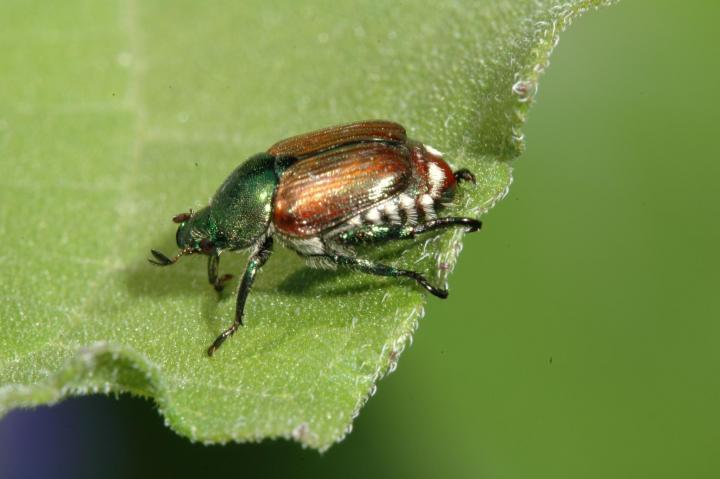
Life Cycle of the Japanese Beetle
The first beetles to emerge start to look for suitable plants to eat and start feeding immediately. They also send out an odor known as a congregation pheromone to signal later emerging beetles where to go. Mating starts soon after.
The females will feed on your plants for a couple of days and then burrow into the soil to lay their eggs. Shortly after, they will return to feeding and mating and start the cycle all over again. By the end of the season, each female Japanese beetle will have laid about 50 eggs.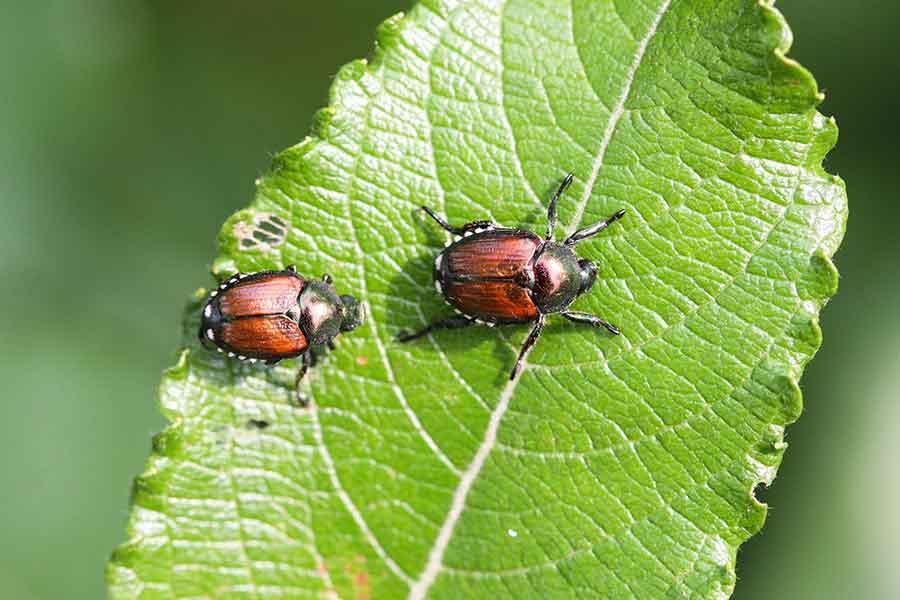
Eggs develop at different rates in different soil temperatures, developing most rapidly in warm soils of about 80 to 90 degrees F. Once they develop into larvae, they will move up toward the surface of the soil and start feeding on roots and organic matter. This is why grub control is usually applied in late summer to fall. The pesticide needs to be applied while the grubs are feeding on the grass roots.
As the soil cools and the grubs mature, they start moving back down deeper into the soil for winter. They’ll stay there until the soil warms in the spring, at which time they burrow back up toward the surface where they’ll pupate and eventually emerge as adults.
What Plants do Japanese Beetles Eat?
There’s a wide smorgasbord of plants for Japanese beetles to feast on, over 300 varieties of trees, shrubs and non-woody plants. Some of their favorites include roses, maples, elms, grapes and crab apples. However, they also feed on weeds like poison ivy and bracken.
How to Control Adult Japanese Beetles
It’s impossible to get rid of Japanese beetles entirely. More will fly in as the current crop are killed. There aren’t many natural controls for adult Japanese beetles. Birds aren’t partial to them, and although some predatory wasps and flies have been imported, their population isn’t large enough yet to control the Japanese beetle problem.
The most effective natural control is to go into your garden with a jar of soapy water and knock the beetles into it. Japanese beetles feed in groups, starting at the top of plants, so it’s pretty easy to fill a jar with them.
Insecticidal soap will kill adult Japanese beetles only if it is sprayed directly on the beetle. It does not have any residual effect, meaning that beetles that aren’t sprayed directly won’t be harmed.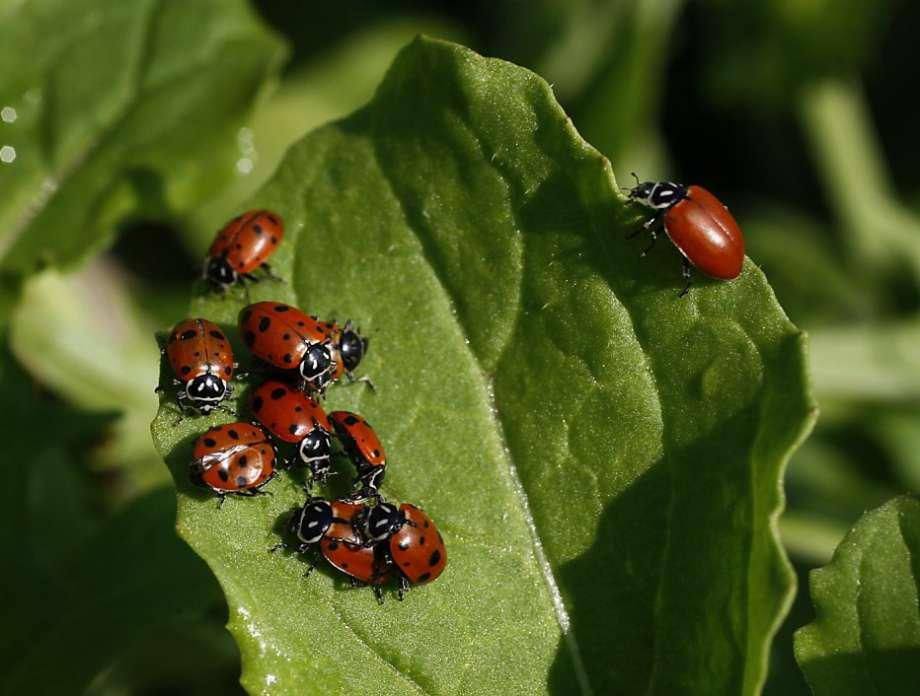
A word of caution about the pheromone beetle traps. They will attract beetles; you’ll probably wind up with more beetles coming into your yard than you would have without the trap. The original intention of the traps was to track when and how many Japanese beetles were in the area, not as a means of eradication.
Finally, if you have repeated intense infestations, you should check your soil in late summer to see if you have a large grub population. Lift a 1 square foot section of turf. If there are more than a dozen grubs in this small area, consider treating your lawn with some type of grub control. However, not every garden that has a Japanese beetle problem is associated with a lawn full of grubs. The beetles can hatch in your neighbor's lawn and find your tasty garden with very little effort.
More Toxic Controls (to Be Used With Caution)
There are several insecticides labeled for use on adult Japanese beetles. These sprays will kill on contact and also have some residual effect. Keep in mind that these sprays will kill more than just the Japanese beetles, so use them only for extreme infestations. And again, Japanese beetles are only a pest for a little over a month, so don’t overreact. Always read and follow label directions when using any pesticide.

An individual Japanese beetle doesn’t do that much damage while feeding on a plant, but they tend to congregate in large numbers and can easily defoliate shrubs and trees. These bugs are hard to get rid of, but there are steps you can take to control them. Keep in mind that the adult Japanese beetles are only around for a little over a month, so don’t automatically reach for harsh chemicals unless they become a serious problem.

Stages of Development
Beetles typically go through 4 stages of development. It’s important to know when they are passing through each stage in your climate because control methods are different for each stage.
The life stages for the Japanese Beetle are:
Egg: Small, oval, white eggs. These are laid in the soil. If moisture is sufficient, they will absorb it and enlarge, becoming rounder as they do.
Larvae: This is the white grub stage that is so familiar in lawns. Japanese beetle larvae have a V-shaped series of bristles on their raster (the underside of the tip of the abdomen.) Grubs will grow in length as they feed and mature.
Pupae: The pupae stage is where the grub starts to transform into a beetle. Japanese beetle pupae start out cream colored and age to a reddish brown.
Adult Beetle: The adult beetles are about 3/8 inch long, and the shell is a shiny, metallic green with copper-brown wing covers. Adults emerge from the ground between May and June, depending on your area. They live for about 30 to 50 days.

Life Cycle of the Japanese Beetle
The first beetles to emerge start to look for suitable plants to eat and start feeding immediately. They also send out an odor known as a congregation pheromone to signal later emerging beetles where to go. Mating starts soon after.
The females will feed on your plants for a couple of days and then burrow into the soil to lay their eggs. Shortly after, they will return to feeding and mating and start the cycle all over again. By the end of the season, each female Japanese beetle will have laid about 50 eggs.

Eggs develop at different rates in different soil temperatures, developing most rapidly in warm soils of about 80 to 90 degrees F. Once they develop into larvae, they will move up toward the surface of the soil and start feeding on roots and organic matter. This is why grub control is usually applied in late summer to fall. The pesticide needs to be applied while the grubs are feeding on the grass roots.
As the soil cools and the grubs mature, they start moving back down deeper into the soil for winter. They’ll stay there until the soil warms in the spring, at which time they burrow back up toward the surface where they’ll pupate and eventually emerge as adults.

What Plants do Japanese Beetles Eat?
There’s a wide smorgasbord of plants for Japanese beetles to feast on, over 300 varieties of trees, shrubs and non-woody plants. Some of their favorites include roses, maples, elms, grapes and crab apples. However, they also feed on weeds like poison ivy and bracken.
How to Control Adult Japanese Beetles
It’s impossible to get rid of Japanese beetles entirely. More will fly in as the current crop are killed. There aren’t many natural controls for adult Japanese beetles. Birds aren’t partial to them, and although some predatory wasps and flies have been imported, their population isn’t large enough yet to control the Japanese beetle problem.

The most effective natural control is to go into your garden with a jar of soapy water and knock the beetles into it. Japanese beetles feed in groups, starting at the top of plants, so it’s pretty easy to fill a jar with them.
Insecticidal soap will kill adult Japanese beetles only if it is sprayed directly on the beetle. It does not have any residual effect, meaning that beetles that aren’t sprayed directly won’t be harmed.

A word of caution about the pheromone beetle traps. They will attract beetles; you’ll probably wind up with more beetles coming into your yard than you would have without the trap. The original intention of the traps was to track when and how many Japanese beetles were in the area, not as a means of eradication.
Finally, if you have repeated intense infestations, you should check your soil in late summer to see if you have a large grub population. Lift a 1 square foot section of turf. If there are more than a dozen grubs in this small area, consider treating your lawn with some type of grub control. However, not every garden that has a Japanese beetle problem is associated with a lawn full of grubs. The beetles can hatch in your neighbor's lawn and find your tasty garden with very little effort.

More Toxic Controls (to Be Used With Caution)
There are several insecticides labeled for use on adult Japanese beetles. These sprays will kill on contact and also have some residual effect. Keep in mind that these sprays will kill more than just the Japanese beetles, so use them only for extreme infestations. And again, Japanese beetles are only a pest for a little over a month, so don’t overreact. Always read and follow label directions when using any pesticide.
0
0
文章
权问薇
2017年09月12日


1、#文竹
1、图下这棵文竹只长枝,不长叶,光秃秃的很难看。必须要修剪一下。

2、打顶,将部分徒长的、生长不良的枝条剪去,控制株型,剪成比较紧凑的形状。

3、修剪次日减少浇水量。一周之内使土壤保持略干燥的状态,否则文竹会发黄打蔫。很快,底下就窜出来新叶子,看起来比之前丰满多了。这时可以恢复浇水了。

2、金钱树
1、金钱树主要是观叶。枝茎如果长得不齐整,就会显得杂乱无章,缺乏美感。

2、将交叉枝、徒长枝、平行枝,都剪掉。一般修剪成,中间几根叶片高高直立,四边弧形向外扩展的形状。

3、树干上会长出许多小侧芽,应该及时摘除,避免耗费营养。

3、橡皮树
1、橡皮树,主要是欣赏它挺直修长的茎干,和宽大肥厚的叶片。

2、如果是小型橡皮树,要及时掰掉多余侧枝,避免浪费养分,也使形象更为清爽。

如果是大型橡皮树,最好只留主干周围一圈5个侧枝,多则就过于重叠,看起来太密,且易造成黑腐。
3、若是橡皮树枝叶稀疏,一枝独秀,则可以切掉主干上半部分,约1/3,参考上图。以促进萌发侧枝。

4、龟背竹
1、龟背竹叶子宽大,任由它自由生长,会长出很多徒长枝叶,交叠在一起,显得杂乱。因此要修剪徒长枝叶。

2、剪掉鹤立鸡群的高枝,矮化植株,是整体显得和谐,同时能促进侧枝的萌发,使造型显得丰满。

5、三角梅
1、花后枝、弱枝、徒长枝,都剪掉。剪出层次,以便在秋冬不开花的时候,也能欣赏株型。

2、把过密的枝条疏剪一下,使整个株型回缩,尽量让每一根枝条都能接受光照。

6、蟹爪兰
1、蟹爪兰生长速度较快,当一个节长出4~5个新枝时,就要及时剪掉其中的2个。以积蓄冬天开花的养分,且看起来美观自然。

2、剪掉过密的、老化的枝条,利于内部通风透气,否则易发生腐烂现象。▲

0
2
文章
stone
2017年09月12日
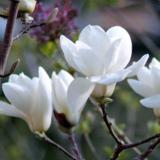
有花友问起#花韭 怎么种植,只要有阳光,种植难度就So Easy了,花韭叶片扁平、气味,都和韭菜差不多,春季开花,从3月开始开花,一直开到6月,夏季休眠。
花韭种植需有日照,避免徒长,环境以温暖避风处最佳,日常浇水适量,不宜太干,介质有一点湿度即可,夏季叶枯可挖出球根放通风干燥处储藏,待秋凉再种植,很容易种植的花卉。冬季尽量少浇水,最好放室外(花韭耐寒),要经过一段冷冻期,花儿才开得多。
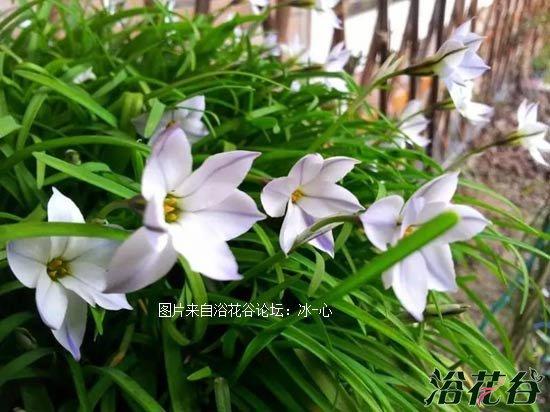
有花友友问花韭什么时候种栽植,一般来说是秋冬季,球根种植深度约球的一倍深度即可。
花韭和韭兰的区别
花韭和韭兰的花很相似,区别在于花韭的花是春天开,韭兰的花是夏秋开。另外,花韭真的是韭菜味道,韭兰则只是形似韭菜,但是没有韭菜味道,只有少数夜开型或杂交品种具有明显且浓烈的香气。从外型上看,花韭花小,植株也小,葱兰、韭兰花大,植株也大。
花韭种植需有日照,避免徒长,环境以温暖避风处最佳,日常浇水适量,不宜太干,介质有一点湿度即可,夏季叶枯可挖出球根放通风干燥处储藏,待秋凉再种植,很容易种植的花卉。冬季尽量少浇水,最好放室外(花韭耐寒),要经过一段冷冻期,花儿才开得多。

有花友友问花韭什么时候种栽植,一般来说是秋冬季,球根种植深度约球的一倍深度即可。
花韭和韭兰的区别
花韭和韭兰的花很相似,区别在于花韭的花是春天开,韭兰的花是夏秋开。另外,花韭真的是韭菜味道,韭兰则只是形似韭菜,但是没有韭菜味道,只有少数夜开型或杂交品种具有明显且浓烈的香气。从外型上看,花韭花小,植株也小,葱兰、韭兰花大,植株也大。
0
1
文章
权问薇
2017年09月12日

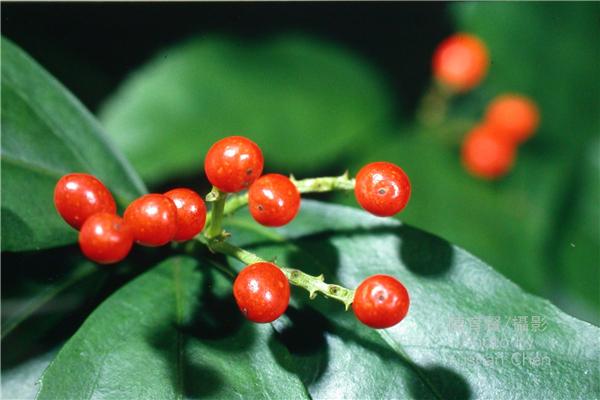
扦插繁殖
一般扦插繁殖是在3到4月进行,首先需要在长得特别健康的植株上选择1到2年生的枝条,将它们剪成2到节,长在10到15厘米之间的插穗,把它们捆起来。然后把它们的基端放在0.05ml/l的3号ABT的生根粉溶液里面浸泡两三分钟后,再放进1ml/l的NAA溶液里迅速蘸一下就可以扦插了,这样会明显增加成活率。插完之后一个月就能生根了,成活之后要及时松土,还可以适量的追肥,加快生长。
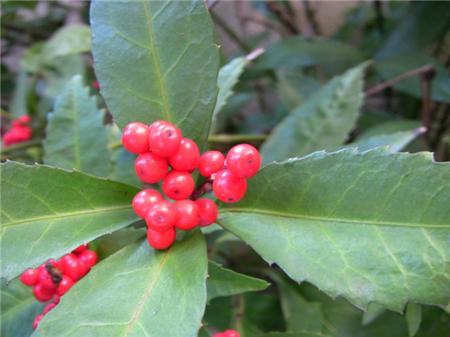
种子繁殖
一般可以在10到12月份果实成熟的时候来采取种子,然后按照晾份湿的细沙,一份种子的比例搅拌后放在室内比较干燥通风的地方放好,或者是也可以放在木箱子里贮藏,同样是置于通风的室内。等到第二年的2到3月份就可以拿出种子来播种了。大约过20天就能够出苗了。也需要在育苗的时候松土施肥,促进成长。
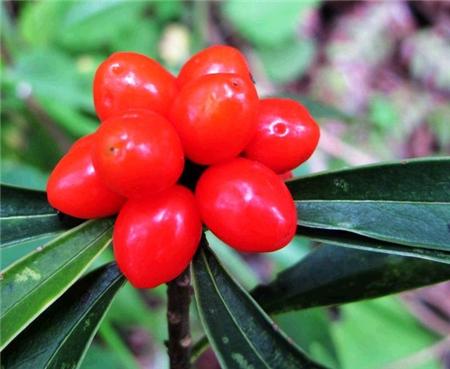
分株繁殖
这种方法适合在早春或是晚秋的时候进行,把草珊瑚在土壤上方10厘米的地方割下来,把剩下的挖出,按照茎秆分别切成带着根系的小株栽种。之后要连续的浇水养护,使土壤保持合理的湿度,及时施肥,除草。这种方法的成活率以及生长速度都很高。
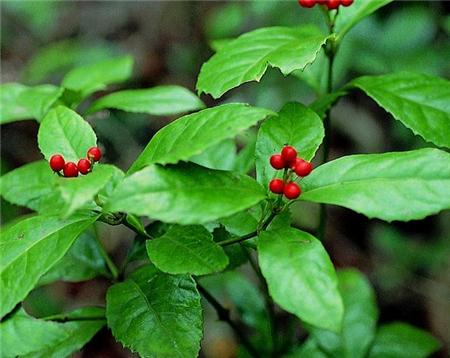
0
0
文章
权问薇
2017年09月12日

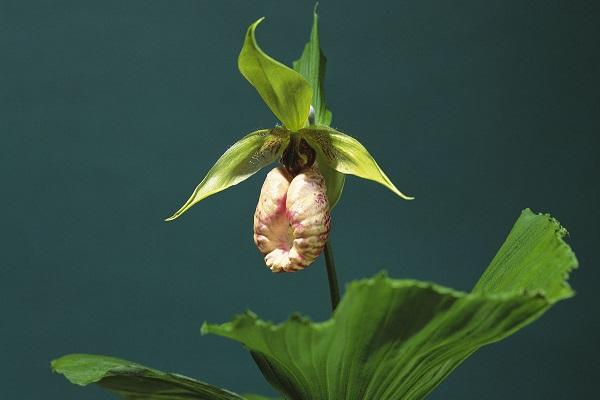
花盆与土壤的选择
#杓兰 最佳栽种时期是每年的3月至4月,秋天的10月至11月进行。杓兰需要透气的环境,所以在选择花盆时尽量选择素烧的陶瓷花盆,不建议使用塑料花盆与带有花纹图案的陶瓷盆。在土壤的选择方法,尽量使用原生态土。
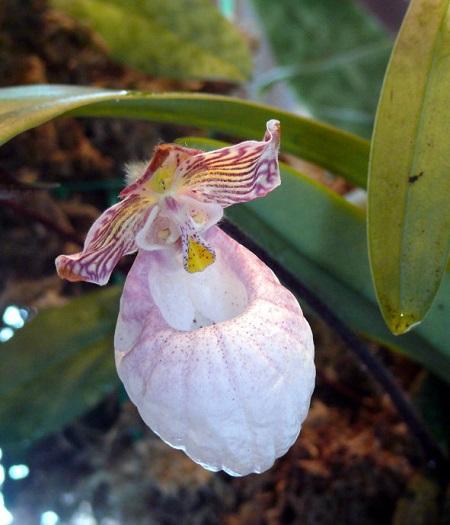
温度
杓兰的最佳生长温度是10度至20度之间,若温度超过25度,要立即进行降温,不然杓兰很容易被热死。在我国的南部与北部,在气温过高时,要移至有冷空气的室内生存,不然很难养殖成功。
浇水
杓兰在生长期内稍微缺水,便可导致期健康受损。所以要勤观察,若土壤有八分干的状态,刚需要浇水。每次浇水时一定要浇透。浇水的次数要根据土壤的干湿度而定。

光照
在阳光过强时,要做好适当的庇荫。想让杓兰晒阳关可以选择在上午9点之前,与下午6点之后进行。但在炎热的夏季,无论何时都不要使阳光直晒。
种植及培土
栽种前要先把新发出芽的枝条中的老旧叶子剪除干净,把已经腐烂根茎剪除。然后把已经处理好的带有新发芽的枝条平放在花盆里,上面覆盖薄土,要将新发的芽全部露出即可。最后用泡过水的白苔铺在花盆最上层,在浇水,要一次性浇透,但不能出现积
0
0
文章
素雅
2017年09月12日

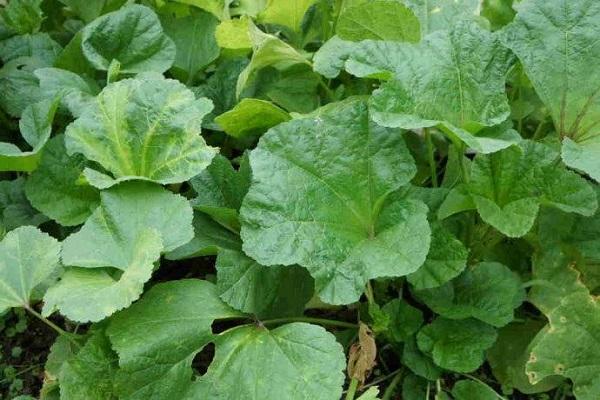
生长环境
冬寒菜喜欢阴凉的环境,除了炎热的酷夏与寒冷的冬季,其它时间随时可以种植。冬寒菜适合在15度至20度的温度中生长。3月份、8月份下旬、9月份上旬是种植冬寒菜的最佳时间。
盆土选择
选择的花盆若是直径是20厘米的,那么大约可以种10粒至12粒的种子。把种子轻轻按在土壤里即可,上面覆盖一层约1厘米厚的土壤。浇透水,但要注意别把种子冲出来。若温度过低时,可把花盆移到室内放置,温度过高时,要注意通风,降温。
发芽
3月份撒种种植,大约8天至10天便可发出萌芽。8月份下旬、9月份上旬撒种种植,发芽的时间会更短。
定植
在冬寒菜的小苗长出4片至6片叶子时,就可以把稍小的、多余的苗拔除,眔下壮硕的小苗。
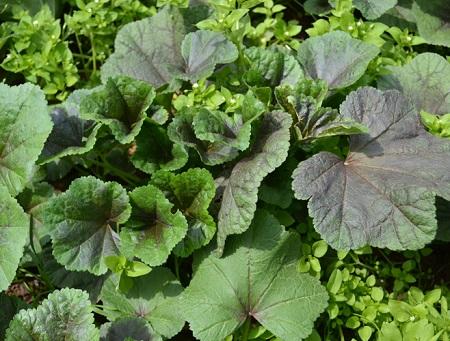
肥水管理
在冬寒菜为小苗时,要少浇水,少施肥;在苗生长到较大时,可以增加水量也肥量。
病虫害防治
家庭盆栽的冬寒菜,病害虫极少,只有害虫会出现,但可以人工捕杀。
采收
如果是3月份种植的,约70天至80天,冬寒菜生长到18厘米高时,便可采收,7天至10天就可以采收一次。8月份下旬、9月份上旬种植的,约50天至60天,同样冬寒菜生长到18厘米高时,便可采收,6天至9天可采收一次。
0
1
文章
素雅
2017年09月12日

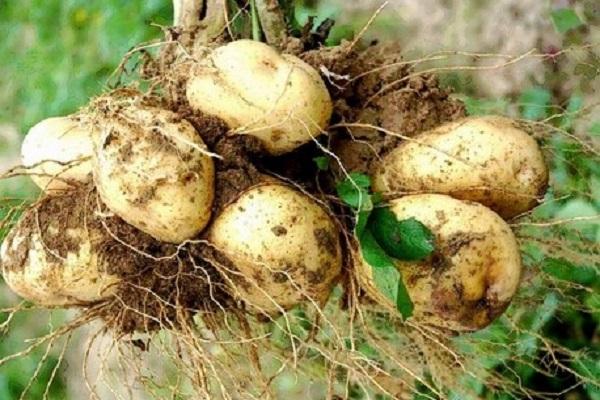
繁殖方式:育种和播种两种方式。
育种繁殖方式:
世界上种植马铃薯的技术有很多,也是因地理环境、气候环境不同而种植也不同,但它的繁殖之式却是相同的。育种是指选用直径在3厘米左右的马铃薯进行种植。在选择育种的马铃薯时,一定要却保其马铃薯种的健康。种植前要对土壤进行消毒与施肥,提前10天对土壤进行浇灌。到了花期,要及时施肥,以确保其产量。
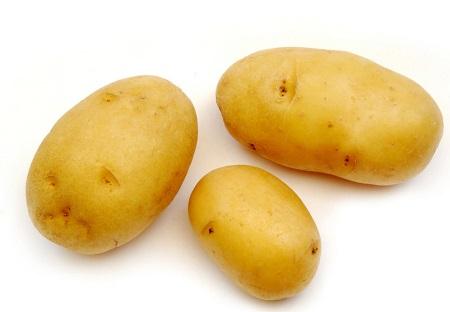
播种繁殖方式:
选取健康的马铃薯,用刀切成块,栽种在土壤里。栽种时要定好间距,不宜过密,否则会影响全部的健康生长。3月份是适合马铃薯播种的时间。播种要做的前提准备就是给土壤消毒。提前10天对土壤进行浇灌。到了花期,要及时补给养分,以确保其产量。
#马铃薯 很耐储藏,又富含很高的营养价值,还可以当做主食来食用。小编的家乡把马铃薯称之为土豆,家家都会储藏一些。马铃薯的原产地很多人都为是中国,其实不是,原产地为南美洲,马铃薯最初是被一位叫安.奥巴曼的农学家发现其可以食用,然后开始大规模、大面积种植马铃薯。
0
3









